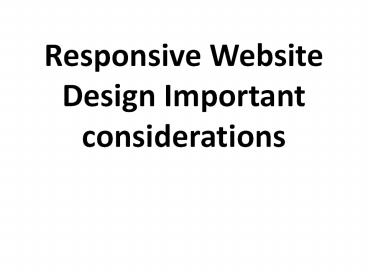Responsive Website Design Important considerations PowerPoint PPT Presentation
Title: Responsive Website Design Important considerations
1
Responsive Website Design Important
considerations
2
- It's no longer enough to have a static website
design that only looks good on a computer screen,
particularly as the internet is increasingly
accessed via mobile devices. - Not to mention, when designing a layout, you must
take into consideration tablets, 2-in-1 laptops,
and various mobile models with various screen
sizes. - You will ensure that your website looks fantastic
on mobile phones, tablets, laptops, and desktops
by using responsive web design. - And a better user experience means more
conversions and increased revenue.
3
What Is Responsive Web Design and How Does It
Work?
- Responsive web design is a technique that enables
the content to adjust to various screen and
window sizes on a number of devices. - For example, the content can be divided into
separate columns because they are large enough to
accommodate the design. - It would be difficult for users to read and
interact with your content if you split it into
several columns on a mobile device. - Responsive design allows you to offer several,
distinct layouts of your content and design to
various devices based on screen size.
4
Adaptive Web Design vs. Responsive Web Design
- Responsive design differs from adaptive design in
that responsive design adapts the rendering of a
single page version. - Adaptive design, on the other hand, produces
several entirely different versions of the same
website. - Both are important web design trends that allow
webmasters to monitor how their site appears on
different screens, but they take different
approaches.
5
- Users can access the same basic file through
their browser regardless of platform when using
responsive design, but CSS code will monitor the
layout and make it differently depending on
screen size. - A script in adaptive design tests for the screen
size and then accesses the template generated for
that device.
6
Why Is Responsive Design Important?
- You may be wondering why responsive design is
important if you're new to web design,
development, or blogging. - The solution is straightforward. Designing for a
single computer is no longer feasible. Mobile web
traffic has surpassed desktop traffic and now
accounts for more than 51 of all website
traffic. - You can't just serve a page built for desktop to
over half of your potential users who use a
mobile device to access the internet. It will be
difficult to read and use, resulting in a poor
user experience.
7
- Mobile users still make up the majority of search
engine visits. - Finally, mobile has grown as one of the most
significant advertisement platforms in recent
years. - The vast majority of your traffic will come from
smartphone users, whether you advertise on social
media or use an organic approach like YouTube
SEO. - You won't be able to maximise the ROI of your
marketing campaigns if your landing pages are not
mobile-friendly and simple to use. Poor
conversion rates would result in less leads and
wasted advertising.
8
Important consideration for Responsive Web Design
- The user experience is crucial, so responsive
design must go beyond merely translating a
desktop site to a mobile device. When using a
mobile device, we must consider the user's
experience, engagement, and the important
information they're looking for. - Don't make the designs for the most recent mobile
device with a particular screen size. Instead,
create a site that revolves around your content.
What will the layout and elements look like on a
desktop computer, and how will they adapt to each
other on a mobile device?
9
- The hierarchy of the layout is extremely
important for engagement, particularly on mobile.
Since the mobile experience is much more oriented
than the desktop experience due to the small
amount of space available, the way users read and
navigate through the web must be extremely
straightforward in order to convey your main
message and understand what the site is all
about. Consider the page's main action as well.
If the main aim is to get people to press a
"contact us" button, don't bury it under a
mountain of text. Build content and a template
that is customised to that experience.
10
- The importance of flexible images in the design
of a responsive website cannot be overstated. - You must consider how a picture would scale.
- What would it look like on a big desktop screen,
a tablet, and a tiny smartphone screen? From a
development standpoint, the code will allow
images to scale to the width of the browser
window using a percentage value.
11
- On a mobile device, navigation is crucial. Wide
menus and content can be compiled in a number of
ways. It may be in the familiar hamburger menu
format, a basic dropdown list, expand/collapse
fields, or horizontally scrolling tabs like
YouTube. - Create at least three different versions for
different browser widths. Below 600px,
600px-900px, and 900px are the sizes we use.
Your content can scale freely between those
widths, or you can hold three set formats. Fluid
scaling is normally more difficult to design and
execute than having three (or more) fixed
templates and adding margins as required. Fluid
scaling can provide a better experience on a
wider range of devices.
12
- Read More- Expand your business with E commerce
web design

